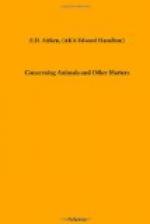When we pass from reptiles to birds, lo! an astounding thing has happened. That there were flying reptiles in the fossil ages we know, and there are flying beasts in our own. But the wings of these are simple mechanical alterations, which the imagination of a child, or a savage, could explain.
The hands of a bat are hands still, and, though the fingers are hampered by their awkward gloves, the thumbs are free. The giant fruit bats of the tropics clamber about the trees quite acrobatically with their thumbs and feet.
That Apollyonic monster of the prime, the pterodactyl, did even better. Stretching on each little finger a lateen sail that would have served to waft a skiff across the Thames, it kept the rest of its hands for other uses. But what bearing has all this on the case of birds? Here is a whole sub-kingdom, as they call it, of the animal world which has unreservedly and irrevocably bartered one pair of its limbs for a flying-machine. The apparatus is made of feathers—a new invention, unknown to amphibian or saurian, whence obtained nobody can say—and these are grafted into the transformed frame of the old limbs. The bargain was worth making, for the winged bird at once soared away in all senses from the creeping things of earth, and became a more ethereal being; “like a blown flame, it rests upon the air, subdues it, surpasses it, outraces it; it is the air, conscious of itself, conquering itself, ruling itself.” But the price was heavy. The bird must get through life with one pair of feet and its mouth. But this was all the bodily furniture of Charles Francois Felu, who, without arms, became a famous artist.
A friend of mine, standing behind him in a salon and watching him at work, saw him lay down his brush and, raising his foot to his head, take off his hat and scratch his crown with his great toe. My friend was nearly hypnotised by the sight, yet it scarcely strikes us as a wonder when a parrot, standing on one foot, takes its meals with the other. It is a wonder, and stamps the parrot as a bird of talent. A mine of hidden possibilities is in us all, but those who dig resolutely into it and bring out treasure are few.
And let us note that the art of standing began with birds. Frogs sit, and, as far as I know, every reptile, be it lizard, crocodile, alligator, or tortoise, lays its body on the ground when not actually carrying it. And these have each four fat legs. Contrast the flamingo, which, having only two, and those like willow wands, tucks up one of them and sleeps poised high on the other, like a tulip on its stem.




